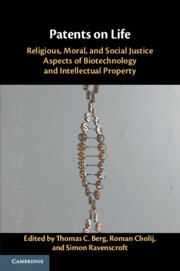 Patents on Life
Patents on Life from III - Social Justice and Political Aspects
Published online by Cambridge University Press: 28 September 2019
Providing sufficient, healthy food to a rapidly growing world population requires maximising agricultural innovation and its use. Intellectual Property (IP) can play an important enabling role, but is also seen by some as an obstacle. This chapter discusses the root causes of the negative perception of IP and explores solutions that can foster a constructive and ethical use of IP. Patents and plant breeders’ rights provide incentives for different plant-related innovations, which can in principle be complementary, fostering a broad range of innovations. Current tension between the two systems seems to result less from what can be protected, and more from a non-harmonized use of rights resulting from the two systems. The chapter argues that solutions exist, especially if they rely on a combination of industry-based provisions, encouraged and supported by legislative frameworks. These can achieve a cultural shift from “exclusivity and value capture” to “access and benefit sharing” and encourage an ethical use of patents on seeds: one that does not limit access to genetic resources and solutions for food security. The international licensing platform for vegetables, based on the principle of “free access but not access for free”, is an example of such a new use of IP.
To save this book to your Kindle, first ensure no-reply@cambridge.org is added to your Approved Personal Document E-mail List under your Personal Document Settings on the Manage Your Content and Devices page of your Amazon account. Then enter the ‘name’ part of your Kindle email address below. Find out more about saving to your Kindle.
Note you can select to save to either the @free.kindle.com or @kindle.com variations. ‘@free.kindle.com’ emails are free but can only be saved to your device when it is connected to wi-fi. ‘@kindle.com’ emails can be delivered even when you are not connected to wi-fi, but note that service fees apply.
Find out more about the Kindle Personal Document Service.
To save content items to your account, please confirm that you agree to abide by our usage policies. If this is the first time you use this feature, you will be asked to authorise Cambridge Core to connect with your account. Find out more about saving content to Dropbox.
To save content items to your account, please confirm that you agree to abide by our usage policies. If this is the first time you use this feature, you will be asked to authorise Cambridge Core to connect with your account. Find out more about saving content to Google Drive.